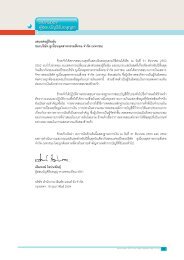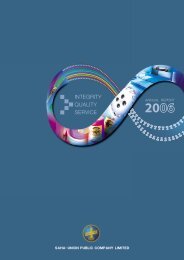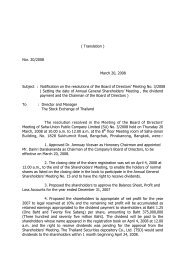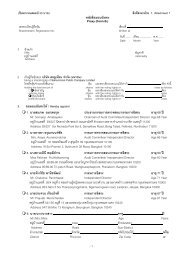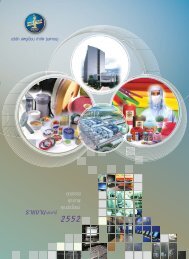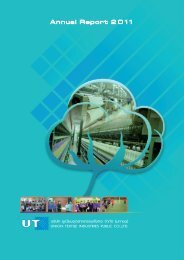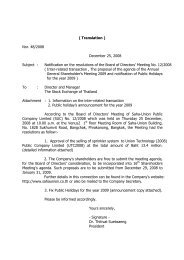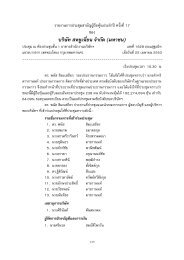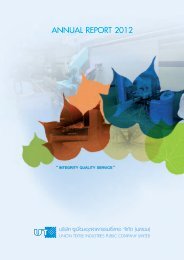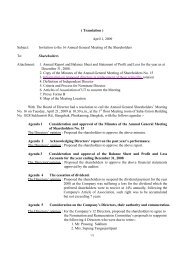INTEGRITY QUALITY SERVICE - Saha-Union Co., Ltd
INTEGRITY QUALITY SERVICE - Saha-Union Co., Ltd
INTEGRITY QUALITY SERVICE - Saha-Union Co., Ltd
Create successful ePaper yourself
Turn your PDF publications into a flip-book with our unique Google optimized e-Paper software.
24<br />
SAHA-UNION<br />
SAHA-UNION PUBLIC COMPANY LIMITED<br />
TEXTILE BUSINESS<br />
TYPES OF PRODUCTS OR <strong>SERVICE</strong>S<br />
<strong>Co</strong>mpanies in the textile group are engaged in the production<br />
of 4 product categories:<br />
1. Garment accessories such as zippers, threads, and<br />
buttons.<br />
2. Fabric textile production from the process of yarn<br />
spinning to fabric weaving. The products are made<br />
of 100% cotton, cotton blended with polyester and/or<br />
synthetic fabrics with special qualifications for making<br />
work wear and fabrics used in other industries.<br />
3. Garment: fashion apparel and work wear.<br />
4. Clean room garments<br />
SUPPLY OF MATERIALS FOR PRODUCTION<br />
OR <strong>SERVICE</strong><br />
The core materials are cotton, mostly imported for the<br />
production process, and synthetic fabric, bought from<br />
domestic suppliers and imported. The production of garments<br />
and clean room garments has fabric and sewing supplies as<br />
core production factors. Fabrics with special qualifications<br />
are partly imported and partly supplied domestically.<br />
PERFORMANCE IN 2011<br />
The production in this group emphasized on technical work<br />
wear as appropriate with the capability of the production<br />
process. In 2011, sales volume increased from the previous<br />
year, due to the price increased in line with the rising costs<br />
of raw materials.<br />
Fabrics’ sales value also increased from the previous year.<br />
63% of all sales was exported, 97.5% of which to EU countries<br />
and the rest to Japan. Domestic sales contributed to 37%<br />
of all sales.<br />
Garment’s sales volume decreased from the previous year,<br />
but sales value increased. 90% of all sales was exported,<br />
88.5% of which to Europe. From such figure, it was inevitable<br />
that the EU economic problem significantly brought down the<br />
orders of textile industry at the end of last year.<br />
As for the market in the first half of the year, since the textile<br />
price continuously increased as from 2010, buyers increased<br />
more orders as they feared of the increasing price. On the<br />
second half, the textile price fell because the economic<br />
recession hit Europe and buyers slowed down their orders<br />
as they waited for the price to fall, resulting in the smaller<br />
demand in the market and severing affecting the competition<br />
in terms of price and delivery period.<br />
In 2011, the fluctuation of raw material prices especially<br />
of cotton was the main problem because cotton was an<br />
imported material; thus, there was limitation of material<br />
supply in terms of quantity and delivery period, resulting in<br />
the loss of opportunity unless it was in sync with the prompt<br />
adjustment of price.



